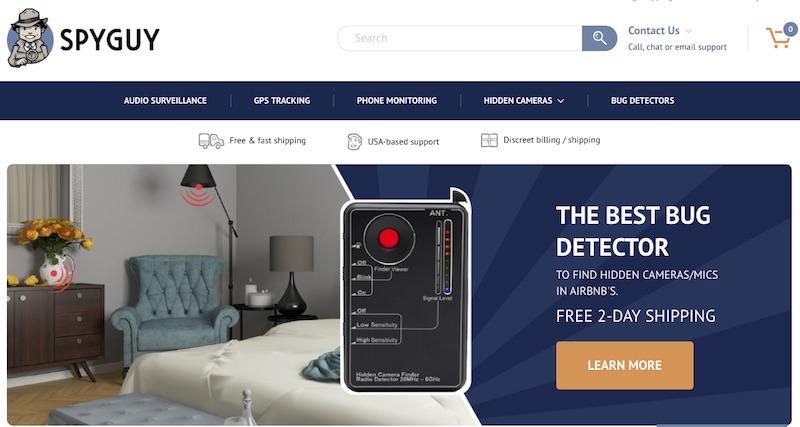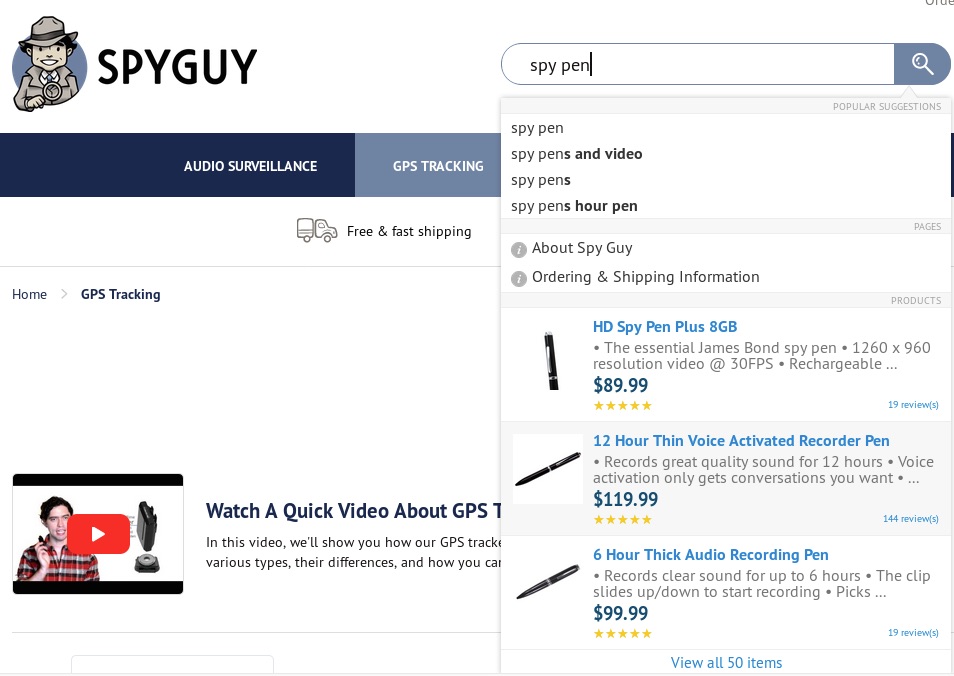
Customers of SpyGuy.com may be families of people with Alzheimer’s or business owners who think their employees are stealing.
SpyGuy.com sells security systems — hidden cameras, surveillance detectors, audio recorders. The company is located in Richardson, Texas, near Dallas.
Allen Walton’s ecommerce site brings in roughly $1 million per year. It offers free ground shipping and lifetime technical support.
The 30-year-old got his start working for a security-products company, selling closed-circuit systems to homes, businesses, and law enforcement. When a customer who wanted to get into the security business asked Walton to help him set up his online store, he jumped at the chance. Then in May 2014, Walton struck out on his own, launching SpyGuy.com.
“Spy equipment can be confusing for people, like you, that have never used it before,” reads the Spy Guy home page. “We’re here to help you get the answers you need.”
SpyGuy.com launched on Shopify. The Spy Guy warehouse stores and ships nearly 100 do-it-yourself security items, most acquired through international distributors. Orders are packed on a “giant table” in the middle of the room, with daily deliveries corralled in a “picking cart.”
“Many people that buy from us don’t know what they want or what they need — they just have a problem. Our real value is in helping our customers find the right product so they can make that problem go away.”
From an office 30 feet from the warehouse, Walton works down the hall from his shipping manager. Nearby are desks for in-house customer support, and a 600-square-foot video studio.
Video Marketing
That video studio is Walton’s pride and joy. “Half of the office is the studio. It’s built for the website, so we’ll have good videos.”
“Most of the videos that are on the website, except the home page video, I filmed a whole year ago. We’re right now redoing our old videos, after having redone the welcome page video — as a test to ensure everything was set up properly. All category pages will have a video, blog posts with videos, how-to videos, that sort of thing.”
The studio started off with a $600 camera, a $200 lavalier (hands-free) microphone, and three $500 studio lights. “[The lights] are good, portable and LED, so they don’t get hot. Since we’re going to be filming videos all the time, we just decided to go ahead and spend money on lights.”
Walton has expanded the studio out since then — adding a second camera for the same price, and a green screen to customize the background.
“When I was starting out, the traditional method was to make a video no longer than 2 minutes. But now most of my videos are over 5 minutes long. And we don’t see any drop-offs from shoppers that are watching our videos.”
Walton also uses the space to photograph every product he sells. A lightbox, bought on Amazon for $450, diffuses the light and provides a catalog-style white background with limited shadowing.
Lightboxes can be created for much less than $450. But Walton states, “Our studio was a little more expensive than it needed to be, just out of convenience.” With no interest in photo editing, he pays Pixc, a photo editing service, around $3 per image to remove any visible background.
Ecommerce Platform
Four years after launching with Shopify, Walton is pleased.
“With Shopify, I can do most everything on my own. It’s really simple,” says Walton. He likes that it works “right out of the box” and he uses its app store for all of his online services and recordkeeping.
“Until two months ago, I was using a $150 Shopify theme, purchased four years ago.”
Walton has recently worked with a developer-designer to redesign the site, to build it from the ground up. To do it, he tapped into the resources at eCommerceFuel, an online community of ecommerce storeowners.
“It’s a private forum of about 700 people, most of whom own six or seven-figure stores. And I found the developer there; he’s a storeowner.”
“I only did the redesign because I wanted a website I was proud of — that I wanted to represent our brand. I didn’t do it to increase revenue. But it has [increased revenue]. I’m a professional ecommerce store now. It had the added benefit of enabling us to make more money. We seem significantly more trustworthy. We looked at all areas of the website: the layout, the navigational elements, our value propositions, a whole new logo, whole new persona, a refined way of talking to our customers and positioning ourselves.”
Operations
All of SpyGuy.com’s back-end management software integrates with Shopify.
“We have been using ShippingEasy’s inventory management software, which automates all of our shipping. Once an order comes in through our website, a label gets automatically printed, for the correct shipper. Everything can be processed in under an hour. All orders before 4 p.m. get sent out the same day.”
Walton’s next move was to Inventory Planner, a Shopify plugin, for $100 a month. “It not only keeps track of our inventory but also does predictive analytics. It tells you when you’ll run out of a product, and it can manually or automatically reorder.”
For search, Walton uses Searchandise, a “fantastic app that makes searching your site so easy. It’s better than the default search because it autocompletes with frequently searched-for items, along with your products’ photos and details. It also shows, from the search bar, the star-rating reviews for all our products — without even having the hit the enter button.”
Plus, Searchandise is customizable, so that Walton can steer search results “to any page we want.” If, for example, someone types in hidden cameras, “rather than give them a list of hidden camera product pages it takes searchers directly to the hidden-camera landing page. It’s totally worth it. It’s great.”

Searchandise autocompletes with frequently-searched items, along with products’ photos and details.
Employees
Walton’s five employees work mainly from home. Their tasks include search engine optimization, fulfillment, and answering shopper inquiries. They’re on call weekdays from 9 a.m. to 7 p.m. Eastern Time — sometimes coming into the office, on busy days, to help with shipments.
The idea of a distributed team came from the book “Remote: Office Not Required,” by the founders of project management software Basecamp. Walton read it and was hooked.
“I said, ‘There’s no reason I can’t have a remote team. There’s no reason they have to come to an office to work.’
“As long as their location doesn’t interfere with their work, they can be in whatever location they want. This allows me to hire the best candidate for the job, rather than just the best candidate nearby.”
Customer Support
SpyGuy.com has an internal call function that all employees use. “I’ve gone through all the call-center software and really like Dialpad,” Walton said.
Dialpad’s platform replaces his small business phone system by powering voice, video, messages, and meetings across employee’s existing devices.
From there, Help Scout makes it “really easy to manage customer communications.” With Help Scout, “every customer has an auto-populated, editable profile [of] their entire history with your company” and every help-desk employee has the CRM-integrated iOS or Android app to email, call through Dialpad, and message through Facebook and LiveChat (a chat provider) “anytime, anywhere.”
Biggest Mistakes
Walton says his biggest mistake was taking a niche where people are “one and done.”
“They buy one thing and don’t need us again. It’s expensive to keep having to get new customers.”
Additionally, the nature of secret spy gear makes it so “we’re not a sharable brand. That’s a really frustrating thing. We put all this effort into having a great company, and it’s [not something our customers tend to share]. The conversations about why people need these items are downers.”
Customers may be families of people with Alzheimer’s, families who suspect elder abuse or abuse by the nanny, business owners who think their employees are stealing, and the list goes on.
If Walton were to start in ecommerce again, “I would want something that is promotable and that people get excited about. I didn’t know it at the time, but I would have loved for it to be consumable, or have cross-selling options, or [be] a subscription business. Something like that would have been smart.”
Finally, Walton cites this mistake: “Not hiring someone [right away] who really knew design, and who really could help with the direction of the website and brand. I should have done that years ago. But I finally did it, and I’m glad I did. Now I have a new website where everything makes sense design wise; it’s structured very intentionally, and our brand looks great across the board.”
Biggest Successes
“We’ve had a lot of small ones that have added up over time. I obtained a great business name [Spy Guy] and bought the domain [SpyGuy.com] for $15,000. It was expensive, but we sound like a Silicon Valley startup. It’s catchy, memorable, and explains exactly what we do … and it’s paying off. None of our products are sold at Walmart. Nobody’s providing tech support. That’s our competitive advantage.”